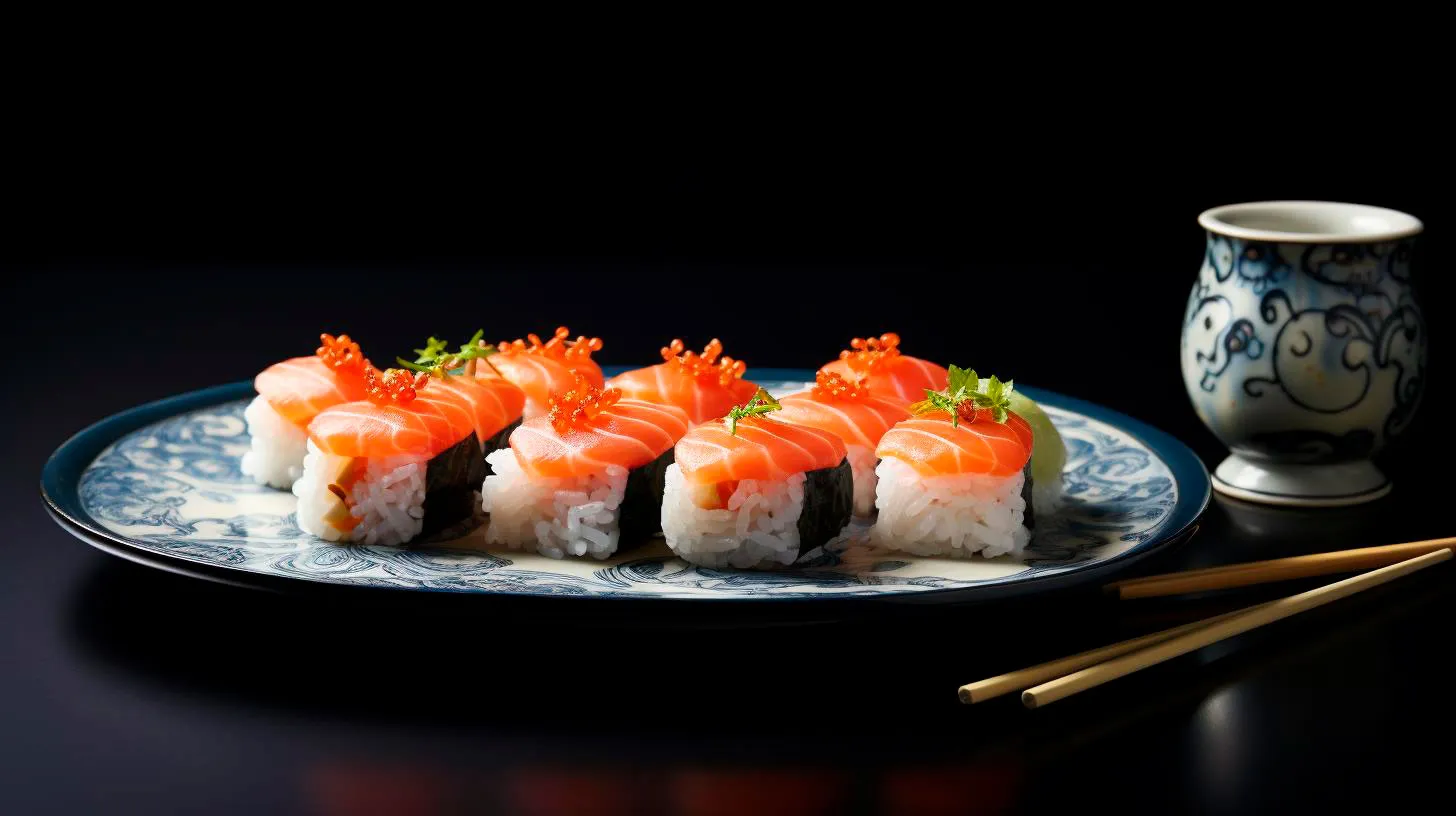Unveiling the Criteria for Selecting Top-Quality Sushi-Grade Fish in Japan
If you are a sushi enthusiast or planning a trip to Japan, it’s essential to understand the criteria for selecting the best sushi-grade fish. In this article, we unveil the secrets behind choosing top-quality sushi-grade fish in Japan.
1. Freshness is Key
One of the most critical criteria for selecting sushi-grade fish is freshness. Freshness not only determines the taste but also plays a vital role in food safety. Fish that is not fresh may lead to foodborne illnesses, ruining your sushi experience. Some factors indicating freshness include:
- Bright Eyes: Look for fish with bright, clear eyes. This indicates that the fish is relatively fresh.
- Glistening Skin: The skin should be shiny, moist, and free from blemishes. Dull or dry skin is a sign of older fish.
- Red Gills: Fish with red gills usually indicates that it was recently caught. Avoid fish with brown or dull-colored gills.
- Firm Flesh: Fresh fish should have firm and resilient flesh. It should spring back when pressed gently.
- Delicate Aroma: High-quality fish should have a clean and faintly oceanic scent. Avoid any fish with overly strong or unpleasant odors.
Remember, a skilled fishmonger can help you identify the freshest fish available, ensuring you enjoy the best sushi experience possible.
2. Origin and Handling
The fish’s origin and how it is handled play a significant role in its quality. Japan is surrounded by abundant seafood-rich waters, making it a prime location for sourcing sushi-grade fish. It’s common for sushi restaurants to obtain their fish through direct relationships with local fish markets or trusted suppliers. When selecting sushi-grade fish, consider the following:
- Local Sourcing: Opt for fish sourced from local waters. Freshness is better ensured when the fish doesn’t have to travel long distances.
- Catching Methods: Fish caught with sustainable methods such as hook and line tend to have superior quality compared to those caught using less sustainable practices.
- Handling Techniques: Proper handling from the moment the fish is caught until it arrives at the restaurant is critical. Fast and careful handling helps maintain the fish’s freshness and quality.
By choosing sushi restaurants that prioritize local sourcing and follow proper handling techniques, you can be confident that you are consuming the highest quality sushi-grade fish.
3. Grading Systems
Japan has several grading systems in place to ensure consistent quality standards for sushi-grade fish. The most commonly used grading system is known as “Tokyo Central Wholesale Market Standard,” which uses a letter grading system ranging from A to D. Here’s a brief overview:
- Grade A: Excellent quality and suitable for high-end sushi restaurants.
- Grade B: Suitable for mid-range sushi establishments.
- Grade C: Commonly used in casual sushi restaurants or for cooked sushi dishes.
- Grade D: Typically used for processed fish products rather than sushi.
It’s important to note that while higher grades ensure superior quality, they also come at a higher price point. However, even fish graded as C can still be delicious and enjoyable for sushi lovers, so don’t be discouraged if your selection falls within this range.
4. Sustainable Fishing Practices
Sustainability is a critical factor to consider when choosing sushi-grade fish. With growing concerns about overfishing and ecosystem preservation, it’s essential to make responsible choices. Look for restaurants and suppliers that prioritize sustainable fishing practices, such as:
- Supporting Local Fisheries: Choose establishments that source fish from local, well-managed fisheries committed to sustainable practices.
- Species Selection: Opt for sushi made from fish species that are not endangered or overfished.
- Traceability: Choose establishments that offer transparency and provide information about the fish’s origin and how it was caught.
By supporting sustainable practices, you can not only enjoy delicious sushi but also contribute to the long-term preservation of our oceans.
Key Takeaways
Selecting top-quality sushi-grade fish in Japan involves considering several critical factors:
- Prioritize freshness by examining the fish’s eyes, skin, gills, flesh, and aroma.
- Choose fish sourced locally for better freshness and sustainability.
- Understand the grading systems to align your expectations with the price and quality.
- Support sustainable fishing practices to protect the environment and seafood populations.
By adhering to these criteria, you can ensure an exceptional sushi experience in Japan while making responsible choices for the environment. Remember, sushi-making is an art, and selecting the finest fish is one of its vital components.
Exploring Regional Varieties: Understanding the Diverse Range of Sushi-Grade Fish
The World of Sushi-Grade Fish
From the icy seas of Scandinavia to the warm waters of Japan, every region offers unique and distinct types of fish that are suitable for sushi. Let’s take a journey through some of the most popular and sought-after varieties:
1. Maguro (Tuna)
Maguro, or tuna, is a staple in sushi restaurants around the world. With its rich flavor and buttery texture, it’s no wonder that tuna is favored by sushi connoisseurs. The most commonly used types of tuna in sushi include:
- Bluefin Tuna: Known for its high fat content, bluefin tuna provides a melt-in-your-mouth experience.
- Yellowfin Tuna: This leaner variety offers a mild flavor and firm texture, perfect for sushi rolls.
Key takeaway: Tuna is a versatile fish with distinct varieties that cater to different taste preferences.
2. Hamachi (Yellowtail)
Hamachi, or yellowtail, is another popular fish used in sushi. Its delicate texture and buttery taste make it a favorite among sushi enthusiasts. Hamachi is widely caught in the coastal waters of Japan and is sourced as fresh as possible to ensure its exceptional quality.
Key takeaway: Hamachi provides a buttery and rich flavor profile, perfect for sashimi.
3. Sake (Salmon)
Sake, or salmon, is beloved for its vibrant orange color and rich, fatty taste. Salmon offers a buttery texture that melts in your mouth. It has become a staple in many sushi creations, including nigiri and rolls. Norwegian and Scottish salmon are popular choices for sushi-grade fish due to their high quality and flavor.
Key takeaway: Salmon offers a unique, rich flavor and is an excellent choice for both cooked and raw sushi dishes.
4. Hirame (Halibut)
Hirame, or halibut, is a prized flatfish commonly used in sushi. Its translucent flesh and delicate, sweet taste make it an appealing choice for sushi lovers. Hirame is known for its clean flavor, and it pairs well with soy sauce and wasabi.
Key takeaway: Halibut adds a subtle, sweet flavor to sushi and is perfect for those who prefer milder tastes.
5. Uni (Sea Urchin)
If you’re feeling adventurous, uni, or sea urchin, is a delicacy that can take your sushi experience to new heights. Uni has a unique buttery texture and a luxurious, briny flavor that is unmatched. It is often served as nigiri or used as a topping for rolls.
Key takeaway: Sea urchin is an acquired taste, but for sushi lovers seeking a luxurious and unforgettable experience, uni is a must-try.
The Importance of Sourcing Sushi-Grade Fish
Now that we’ve explored some regional varieties, it’s important to understand the significance of sourcing sushi-grade fish. Sushi-grade fish goes through meticulous handling, strict quality control, and accurate temperature control to ensure it is safe to consume raw. Some key reasons to prioritize sushi-grade fish:
- Minimizes the risk of foodborne illnesses: Properly handled sushi-grade fish reduces the chances of foodborne pathogens.
- Enhances flavor and texture: Sushi-grade fish has superior taste and freshness, taking your sushi experience to new heights.
- Ensures authenticity: Using proper sushi-grade fish ensures an authentic sushi experience, allowing flavors to shine through.
Sourcing Sushi-Grade Fish: Tips and Recommendations
When sourcing sushi-grade fish for your home sushi-making adventures or dining out, keep the following tips in mind:
- Buy from reputable and trusted sources: Choose suppliers with a reputation for providing high-quality seafood.
- Look for transparency: Reliable suppliers often provide details about the fish’s origin, handling practices, and certifications.
- Consider freshness indicators: Look for fish with firm flesh, bright colors, and a clean smell, indicating freshness.
- Check for freezing: Freezing fish at ultra-low temperatures helps kill parasites, so make sure the fish has undergone this process.
The World of Sushi: An Ongoing Exploration
Sushi is not just food; it’s an art form that brings together flavors, textures, and traditions from around the world. Understanding the diverse range of sushi-grade fish available opens up a world of culinary exploration. So the next time you indulge in a plate of sushi, take a moment to appreciate the journey that brought these exquisite flavors to your plate.
Mastering the Art of Sourcing Fresh Fish for Japanese Sushi
In this article, we will explore the intricacies of sourcing fresh fish for Japanese sushi, from understanding the different types of fish to key considerations when purchasing. Whether you are a professional sushi chef or an enthusiastic home cook, mastering the art of sourcing fresh fish is essential to unlocking the full potential of this revered delicacy.
The Different Types of Fish for Sushi
When it comes to sushi, various types of fish can be used, each offering unique flavors and textures. Here are some of the most commonly used fish in Japanese sushi:
- Maguro (Tuna): Tuna is hugely popular in sushi due to its rich, buttery texture and savory flavor. It is often graded based on its fat content, with higher grades like Otoro and Chutoro being highly sought after.
- Sake (Salmon): Salmon is a versatile fish that can be enjoyed in various sushi preparations. It has a mild, delicate taste that pairs well with other ingredients.
- Hirame (Halibut): Halibut is prized for its firm, yet tender flesh. Its sweet flavor makes it a popular choice for nigiri or sashimi.
- Hamachi (Yellowtail): Yellowtail boasts a delicate, rich flavor and a buttery texture. It is often considered a delicacy and is highly valued in sushi.
- Ika (Squid): Squid has a chewy texture and a subtly sweet flavor. It is a staple in sushi and can be enjoyed in various preparations.
Key Considerations when Sourcing Fresh Fish
When sourcing fish for sushi, freshness is paramount. Here are some key considerations to keep in mind:
1. Quality and Source
Opt for fish that has been sourced from reputable suppliers known for their commitment to quality. Look for certifications such as MSC (Marine Stewardship Council) or ASC (Aquaculture Stewardship Council), which ensure sustainable fishing practices.
2. Appearance and Texture
Inspect the appearance of the fish to ensure it has a vibrant color and clear eyes. The skin should be shiny and free from bruises or discoloration. When handling the fish, it should feel firm and have a springy texture.
3. Smell
Avoid fish with a strong, unpleasant odor, as this is a strong indication that it is not fresh. Fresh fish should have a mild, clean scent reminiscent of the ocean.
4. Handling and Storage
Check how the fish has been handled and stored. It should be appropriately chilled and stored at a temperature below 40°F (4°C) to prevent bacterial growth and maintain its freshness.
5. Frozen vs. Fresh
Frozen fish can be an excellent option for sushi, as it undergoes a process known as flash freezing, which helps preserve its quality. Look for fish that has been properly frozen, with no signs of freezer burn.
The Advantages of Sourcing Fresh Fish
Sourcing fresh fish for Japanese sushi offers a range of advantages, ensuring an unforgettable culinary experience. Here are some key benefits:
- Exceptional Flavor: Fresh fish offers a vibrant and natural taste, allowing the flavors of the sushi to shine through.
- Enhanced Texture: High-quality fish provides a melt-in-your-mouth experience, with the perfect balance of tenderness and firmness.
- Food Safety: Fresh fish reduces the risk of foodborne illnesses associated with consuming raw or undercooked seafood.
- Elevated Presentation: Fresh fish retains its vibrant colors, resulting in visually stunning sushi plates that are as pleasing to the eye as they are to the palate.
Key Takeaways
Sourcing fresh fish is an art form that requires attention to detail and a deep understanding of the ingredients. Here are the key takeaways to remember:
- Know the different types of fish commonly used in sushi, along with their unique flavors and textures.
- Consider factors such as quality, appearance, texture, smell, and handling when sourcing fish.
- Opt for reputable suppliers that prioritize sustainable fishing practices.
- Always choose fresh fish to enhance the taste, texture, and overall sushi experience.
By mastering the art of sourcing fresh fish for Japanese sushi, you are one step closer to creating authentic, delicious sushi that will impress even the most discerning sushi connoisseurs.
Insider Tips Ensuring Optimal Quality When Purchasing Sushi-Grade Fish
In this article, we will explore insider tips to help you navigate the world of sushi-grade fish and make informed choices.
What Does “Sushi-Grade” Mean?
The term “sushi-grade” refers to the quality and freshness of fish suitable for raw consumption. Contrary to popular belief, it is not an official or regulated label but rather a common industry term. Sushi-grade fish is typically caught, handled, and stored under strict conditions to maintain its quality and safety standards.
Tips for Identifying Sushi-Grade Fish:
- Source from reputable suppliers: Purchase sushi-grade fish from trusted suppliers known for their commitment to quality and stringent handling practices. Look for recommendations from experienced sushi chefs or trusted seafood markets.
- Freshness is key: Look for bright, clear eyes, shiny skin, and vibrant colors in the fish. Avoid fish with dull or sunken eyes, discolored patches, or off-putting odors, as these are signs of poor quality or improper handling.
- Transparency in sourcing: Suppliers should be able to provide detailed information about the fish, including its origin, catch date, and handling processes. Opt for suppliers who value transparency and prioritize traceability.
- Proper handling and storage: Sushi-grade fish should be kept at consistently low temperatures to maintain freshness and prevent bacterial growth. Ensure the supplier follows proper handling techniques, such as using ice or refrigeration throughout the transportation process.
- Ask about freezing practices: Freezing fish below certain temperatures for a specific duration can eliminate parasites. Suppliers should be knowledgeable about proper freezing techniques and able to provide evidence of compliance.
The Benefits of Choosing Sushi-Grade Fish:
Opting for sushi-grade fish offers several advantages that enhance your dining experience:
- Superior flavor: Sushi-grade fish is exceptionally fresh, ensuring a delicate and vibrant flavor that elevates your sushi experience.
- Reduced risk of foodborne illnesses: The proper handling and processing of sushi-grade fish minimize the risk of foodborne pathogens, offering a safer dining experience.
- Health benefits: Sushi-grade fish is a great source of omega-3 fatty acids, high-quality proteins, and essential minerals, providing numerous health benefits.
- Supporting sustainable fishing practices: By choosing reputable suppliers who prioritize sustainability, you contribute to the conservation of fish populations and the health of marine ecosystems.
Key Takeaways:
Here are the key takeaways to remember when purchasing sushi-grade fish:
- Choose sushi-grade fish from trusted suppliers who prioritize quality and adhere to strict handling practices.
- Look for signs of freshness such as bright eyes, shiny skin, and vibrant colors.
- Ensure transparency in sourcing by requesting information on origin, catch date, and handling processes.
- Verify that proper handling and storage techniques are followed to maintain freshness and minimize bacterial growth.
- Ask suppliers about their freezing practices to eliminate parasites.
- Enjoy the benefits of sushi-grade fish, including superior flavor, reduced risk of foodborne illnesses, health benefits, and support for sustainable fishing practices.
Choosing sushi-grade fish is an essential step in guaranteeing an unforgettable sushi experience. By following these insider tips, you can confidently select the highest quality fish and savor the flavors of sushi with peace of mind.



